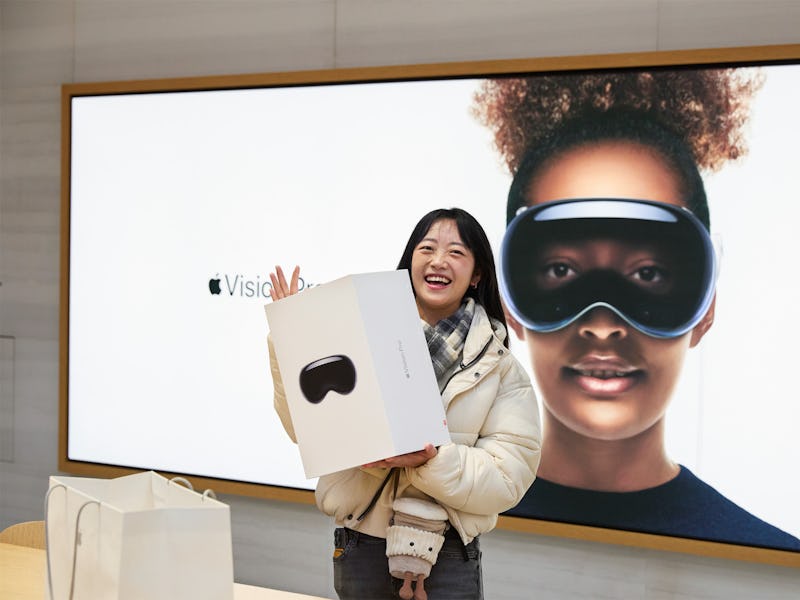6 Reasons Why Apple Doesn’t Need a New Vision Pro Yet
The face-worn “spatial computer” headset doesn’t need an annual refresh.

We’re too used to Apple’s annual release schedule for its iPhones. So much so that we’re conditioned to expect the second-generation generation of the Vision Pro next year.
The latest rumor comes from Bloomberg’s Mark Gurman, who claims that Apple’s product roadmap doesn’t call for a second-gen model until the end of 2026. More than two years out may seem like a long time for Apple, but we think that’s completely reasonable. After all, the Vision Pro just came out in February (and only in the U.S.) and it still feels like we don’t know what the ideal purpose is. Here are six reasons why we shouldn’t expect Apple to release a follow-up to the Vision Pro anytime soon.
6. What Exactly is the Vision Pro Meant For?
Since the Apple Vision Pro can be used for so many things, it’s almost hard to define what it is.
The Vision Pro has been out for just under three months. Since then, we’ve seen people use it for work, gaming, socializing, and even assisting with surgeries. With such a wide range of use cases, we’d like to see Apple figure out a clearer direction for the Vision Pro.
While we saw Apple quickly shift the Apple Watch from a mini iPhone on your wrist to a fitness and health-focused wearable, the company is still figuring out how to succinctly market the Vision Pro. Until Apple solves the Vision Pro’s identity problems, there’s no reason to move on to the next model so fast.
5. Too Expensive for Most People
Not everyone can afford to drop $3,500 on a mixed-reality headset.
It’s hard not to mention the $3,500 price when talking about the Vision Pro. Rightfully so, since many people can’t afford that compared to the Quest 3’s $500 starting price. There have been some rumors floating around about Apple working on a more affordable version of its headset, but according to Gurman, the company hasn’t figured out how to lower production costs yet.
If there are plans to release a cheaper model as a follow-up to the Vision Pro, it sounds like Apple still needs time to decide how to do that. We don’t know if that’s through dropping the EyeSight feature, lowering the resolution of the two displays, or cutting some of the cameras and passthrough capabilities.
4. What to Do With EyeSight
Apple has been putting more stock into its EyeSight feature.
Let’s say Apple drops the EyeSight feature to lower the cost of the next-gen Vision Pro. That means this future headset could lose a crucial feature: Spatial Personas. Considering how this aspect makes using the Vision Pro feel less lonely and more immersive in social settings, we don’t expect Apple to put this up on the chopping block.
First things first, Apple should decide what it wants to do with EyeSight moving forward. It seems like Apple wants to lean more into this unique feature, even just with the current Vision Pro. As goofy as it looks, it still serves a couple of purposes in both mixed and virtual reality settings.
3. Still “Dev Kit” Vibes
We’re still in the growing pains phase of the current Vision Pro.
As polished as the Vision Pro is compared to other headsets, it still feels like a dev kit. The hardware and visionOS are new so Apple and other developers are still experimenting. That’s not to say that the Vision Pro isn’t a finished product, it’s just that the ecosystem isn’t quite there to showcase its full potential.
2. Lack of Some Crucial Native Apps
With no native Netflix app for Vision Pro, some indie developers have made workarounds, like the Supercut app.
Adding to how the Vision Pro still feels like a dev kit, some app developers are dragging their feet on making native apps for Apple’s headset. There are some notable holdouts, including Netflix, YouTube, and Spotify. Without visionOS versions of these apps, users have to go through Safari to use these apps, which often means less functionality.
More than 600 new apps were built for the Vision Pro when it was released, and we’re seeing some impressive ones being introduced. However, it feels severely lacking if a headset is missing the most popular apps, so Apple should address this first.
1. No Real Competition
The Meta Quest Pro might be the only real competitor for the Vision Pro, and it doesn’t come close.
When it comes to a high-end mixed reality headset, we don’t have many options that are comparable to the Vision Pro. You could argue that Meta’s Quest Pro could be a challenger, but it’s not quite as capable when it comes to the interface and intuitive controls.
Without a serious threat to the Vision Pro, Apple doesn’t need to pump out a follow-up since the existing product is already somewhat futureproof. However, if Meta releases a second-gen Quest Pro, we may see some renewed interest from Apple. Until then, the Vision Pro is more than enough.